Tube Feeding Neonatal Small Ruminants by Dr. Susan Kerr
This publication gives a complete overview of the topic of tube feeding neonatal lambs and kids. Relevant anatomy, indications, and techniques are presented. Photographs illustrate the techniques discussed. Information about colostrum, biosecurity, sanitation, and passive transfer of immunity is included as well.
Introduction
It is essential that sheep and goat producers learn how to feed young animals with a stomach tube. This simple procedure can often save a young animal's life, thereby increasing lambing and kidding crop rates and enhancing profitability. With a brief amount of instruction and a little practice, anyone can perform this crucial task quickly, safely, and effectively.
Indications
When is tube feeding necessary? If an animal is too weak or otherwise unable to nurse, it needs to be tube fed. Other situations include maternal factors (lack of milk production, lack of mothering, mastitis, death) and management decisions to control various diseases (C.A.E., O.P.P., Johne's Disease, etc.). Neonates with diarrhea may need to be tube fed with electrolytes.
Importance of Colostrum
Colostrum is the first milk of a mother's lactation period. It is produced by the udder in the last weeks of pregnancy and lasts for a few days after delivery. It is darker and thicker than milk. It contains high levels of fat, protein, vitamins, and special proteins called antibodies. These antibodies are produced by the dam's immune system in response to vaccination or disease exposure. Antibodies protect animals against various diseases such as tetanus, enterotoxemia, and E. coli. Giving dams a booster vaccination two to three weeks before kidding or lambing helps ensure high levels of antibodies in colostrum.
Newborn animals must ingest colostrum within a few hours of birth. A newborn's intestinal tract is not very selective in the first hours of life; antibodies can be absorbed whole, which is essential for their function. After twelve hours, antibodies and other proteins are digested into amino acids and then absorbed; they can be used as a source of nutrition but they no longer have any disease-fighting ability. Producers should strive to ensure adequate colostral intake as soon as possible after birth.
Sources of colostrum, in decreasing preference, include the neonate's own dam, another dam of the same species in the herd, frozen colostrum from the same herd, fresh or frozen colostrum from a neighbor's dam of the same species, fresh or frozen colostrum from another species, and commercial colostrum supplements. Commercial preparations should be considered supplements for poor quality or quantity of colostrum, not as colostral substitutes. Each year, producers should harvest extra colostrum from high-producing animals and freeze it in case of emergency; update frozen colostrum reserves every year. Freezing colostrum in two-ounce portions simplifies future use and reduces waste.
Laboratory tests can confirm the quality of a sample of colostrum by measuring its antibody concentration. Blood tests in neonates over 24 hours old can confirm whether or not they have absorbed sufficient levels of antibodies. The lack of a protective level of circulating antibodies is called failure of passive transfer (FPT). FPT makes a young animal very susceptible to disease; many animals with FPT die of scours or pneumonia within two weeks of birth. After the first 12 to 24 hours of life, the gut is "closed" and can no longer absorb intact antibodies, so the only treatment for FPT is a costly intravenous transfusion of plasma antibodies.
Anatomy
The diagrams below depict simplified cross sections of an animal's head. The swallowing diagram shows the structures of the throat area during swallowing. The breathing diagram shows the same structures during breathing. During swallowing, food and liquids are funneled down the esophagus instead of into the airway by the automatic function of protective flaps of tissue (the soft palate and epiglottis).
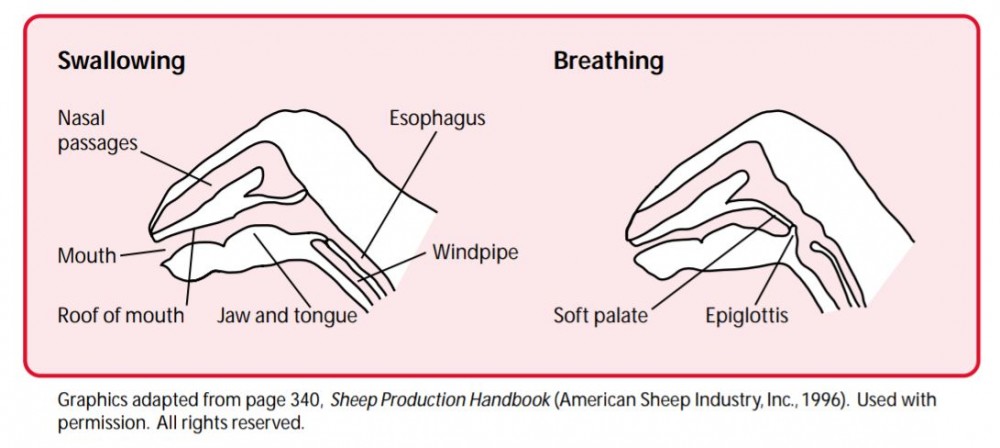
Steps to Tube Feeding
1. Determine that tube feeding is necessary. If a newborn lamb or kid has not nursed within two hours of birth, it should be tube fed. If an animal is nursing or can take a bottle, there is no need to tube feed.
2. If the animal is hypothermic (cold), warm it before administering colostrum. Neonates must be warmed before colostrum can be absorbed properly. Stick your finger in the animal's mouth— if it seems cool, the animal needs to be warmed up. Take it indoors, fashion a wool sweater for it, put it under a safe heat lamp, place it near a wood stove or do whatever it takes to warm it. A moribund animal may need to be immersed in warm water for rapid warming. Dry all neonates thoroughly before putting them outdoors.
3. Warm the fluid to be administered to about 104ºF. There is no need to feed colostrum if the animal is older than 24 hours old—milk will do. Electrolytes should be administered if the animal is weak due to dehydration from diarrhea. Frozen colostrum should be thawed in a warm water bath, not a microwave; microwaving will destroy the antibodies in the colostrum.
4. Assemble sanitized equipment, including a feeding tube and a 60-cc dose syringe. Tube feeding kits are available through livestock catalogs and farm supply stores. An open-ended, 20-inch long piece of soft, flexible tubing, six millimeters in diameter, with a smooth end is a safe and effective stomach tube.
5. Place the tube alongside the neonate's body, with the mouth of the tube at the animal's mouth and the end at its last rib, where the stomach is located (Figures 1 and 2). Note how far the tube will have to be inserted to reach the last rib.
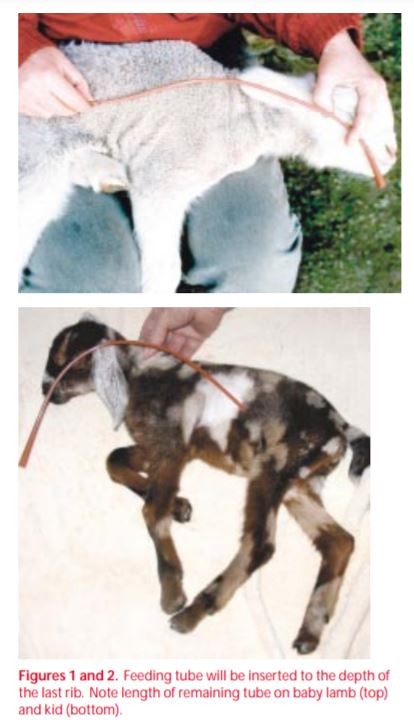
6. Sit in a chair or on a hay bale and restrain the animal by facing it away from you, gently holding it by its shoulders between your knees; the animal's body will dangle down between your legs (Figure 3). Never tube feed an animal on its side or it may inhale the fluid you are administering.
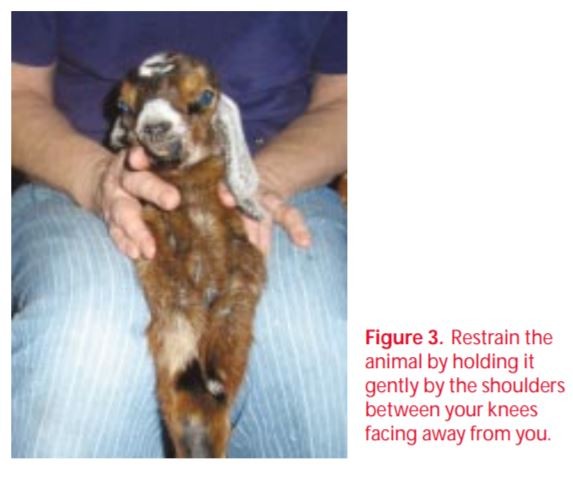
7. Hold the animal so its head is in a normal position. Dip the tip of the tube in clean water and slowly insert the tube in the animal's mouth (Figure 4). There is no need to use pressure or force, just gently advance the tube toward the back of the animal's mouth (Figure 5). The animal should swallow the tube readily (Figure 6). You can see the swallowing motion if you watch carefully.
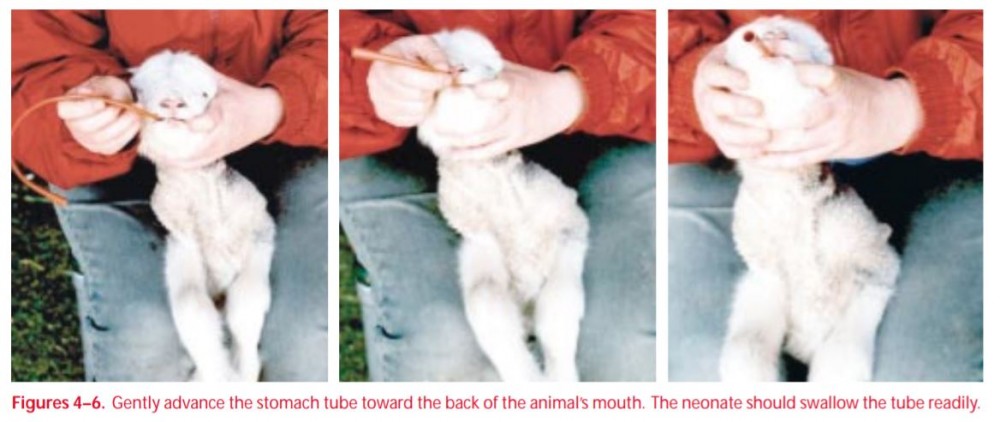
THE GOAL IS TO INSERT THE TUBE INTO THE ESOPHAGUS, NOT THE TRACHEA. If the tube enters the trachea (windpipe), the animal should cough, gag, and react violently, but a moribund animal may not react. An animal that has swallowed the tube can still bleat and cry; an animal that has inhaled the tube can not make these noises. Actually, it is unusual for the tube to enter the trachea.
8. Correct placement of the tube can be checked by several methods, but the first method is the most reliable and effective.
- Best Method: Attach a 60-cc dose syringe to the mouth of the feeding tube after it has been fully inserted into the animal; pull the plunger back. As shown in the photo (Figure 7), it should be very difficult to get the plunger to move past a few cc marks if the tube is placed properly. The pressure created by the plunger causes the thin muscular walls of the esophagus and stomach to be pulled against the hole in the end of the tube. If the tube is improperly placed and is in the trachea, it will be very easy to pull the syringe's plunger. This is because the trachea and lung airways have sturdy cartilage rings and can withstand the negative pressure created when the plunger is pulled back. The air naturally present in the trachea and lungs is pulled back into the syringe very easily. If you understand, master, and perform this check every time you pass a feeding tube, you will never accidentally drown an animal while tube feeding.
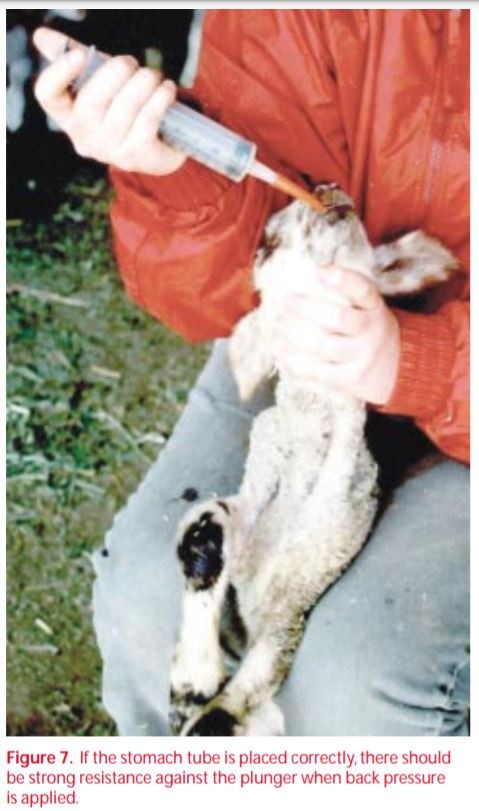
- The animal should swallow as the tube is introduced and advanced.
- Watch the tip of the tube advance in the esophagus on left side of the animal's neck.
- The tube should be inserted to the previously-noted length. (A tube inserted into the trachea cannot be advanced this far.)
- Feel the tube in the esophagus on the left side of the animal's neck. (The tube cannot be felt if it is in the trachea.)
- The animal shouldn't gag or cough.
9. Detach the syringe from the feeding tube and remove the plunger. Firmly re-attach the empty syringe to the mouth of the feeding tube. Fill the syringe with the warmed fluid (Figure 8). Let the fluid trickle in via gravity (Figure 9). Do not force it with the plunger, as the pressure could rupture the stomach or cause fluid to enter the lungs. Thick colostrum may not flow freely; it may need to be diluted with thinner colostrum. Try to keep air from entering the tube and stomach.
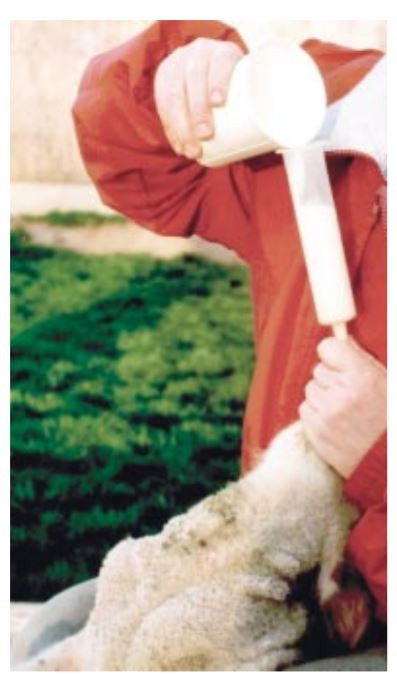


10. After the fluid has been administered, detach the syringe and crimp off or plug the end of the tube as it is withdrawn from the animal as shown in the photo (Figure 10). This prevents the animal from inhaling any fluid as the tube is withdrawn across the pharynx.
How Much and How Often?
An animal should receive at least 10 percent of its body weight in colostrum in the first 24 hours of life. For example, a 10-pound lamb should receive one pound (16 ounces) of colostrum during its first day. Frequent small meals of two or three ounces are better than one or two huge meals. If all goes well, the animal will only need to be tubed once, then returned to its dam to nurse free choice. Animals that do not respond well or do not get stronger within a few hours should have a thorough physical examination.
Biosecurity and Sanitation Concerns
Johne's Disease, Brucellosis, mycoplasmosis, O.P.P., C.A.E., and other diseases can spread to your herd through infected colostrum. If you are using colostrum from another herd, be sure the source is diseasefree or pasteurize the colostrum. In order to pasteurize colostrum without destroying its beneficial antibodies, heat it and maintain a temperature of 133ºF to 134ºF for 60 minutes. To disinfect tube feeding equipment, rinse well immediately after use. Wash thoroughly with warm, soapy water to remove all debris. Dilute one ounce of bleach with 21 ounces of water and submerge all equipment in this solution for two minutes. Remove, rinse well, air dry, and store in a clean place. Wash your hands well before and after tube feeding.
Conclusion
This publication teaches producers how they can easily learn to tube feed neonatal small ruminants with confidence. Every sheep and goat producer should master this skill and have sanitized equipment and frozen colostrum ready during lambing and kidding season. For assistance with this technique or locating tube-feeding equipment, contact your veterinarian or county extension educator. The information herein is supplied for educational or reference purposes only, and with the understanding that no discrimination is intended. Listing of commercial products implies no endorsement by WSU Extension. Criticism of products or equipment not listed is neither implied nor intended.
Supplies
- 60 cc dose syringe
- Stomach tube feeder (available from feed
stores, veterinarians, and livestock supply
stores and catalogs)
- Container with warm milk, colostrum,
or electrolytes
- Disinfectant
The original article can be found at the link below:
Upcoming Events
Cover Crop Breeding Field Walk
April 23, 2024
Freeville, NY
You're invited to join us for a Cover Crop Breeding Field Walk!
The Cover Crop Breeding Network breeds fall-sown cover crops for traits like fall emergence, winter survival, spring vigor, high biomass, hard seed, and non-shattering pods
Join us to walk the trial fields, talk about what we're seeing (and not seeing), hear about past years' results, and learn about CCB lines approaching commercialization.
Advanced line trials - Crimson clover, hairy vetch, winter pea, and winter canola
Planting date trials - Cereal rye and winter pea
Breeding nurseries - Cereal rye and winter pea (across the road & optional!)
Cover Crop Breeding Field Walk
May 1, 2024
Freeville, NY
You're invited to join us for a Cover Crop Breeding Field Walk!
The Cover Crop Breeding Network breeds fall-sown cover crops for traits like fall emergence, winter survival, spring vigor, high biomass, hard seed, and non-shattering pods
Join us to walk the trial fields, talk about what we're seeing (and not seeing), hear about past years' results, and learn about CCB lines approaching commercialization.
Advanced line trials - Crimson clover, hairy vetch, winter pea, and winter canola
Planting date trials - Cereal rye and winter pea
Breeding nurseries - Cereal rye and winter pea (across the road & optional!)
Meat Your Farmer 2024
May 2, 2024 : Meat Your Farmer 2024
East Aurora, NY
This event brings together livestock farmers and the community to learn about local bulk meat sales and to taste recipes created for NYS schools, featuring meats from local farms. We are currently looking for farmers to participate in the event!
Announcements
No announcements at this time.





